 By Jeff Alexander, The Valspar Corporation
By Jeff Alexander, The Valspar Corporation
Architectural design varies across the world, the country and even across town. Variety in design and building products is visually pleasing and unique, but it’s not the only reason architectural trends can be distinct to certain locations. Several factors are considered when designing a building and determining which materials to use, especially when constructing a building that’s within close proximity to the coasts.
The coasts of the United States are home to some of the country’s most impressive architecture. They also get hit hardest with severe weather generated from the ocean and its ever-changing tides. After Hurricane Sandy, we have learned that not even the Northern most parts of the coasts are safe from the elements.
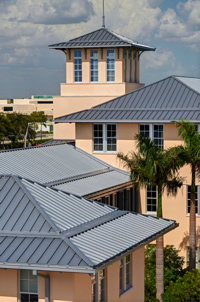
|
Aluminum roofing, protected with architectural coatings from Valspar, checked all the boxes for The New College of Sarasota, FL. To see more on this project, click here. |
When constructing a new building in a coastal climate, it is vital to take the possibility of perilous weather into consideration. Structures that reside near the coasts must be equipped with protection against the elements, and architects must carefully select the ideal building materials to make this possible. With the right materials, a building will be in better shape to take on the dangerous weather produced by Mother Nature, and preserve its style and design.
Violent weather is not the only danger to structures built near the coast. The ocean itself proves a threat to coastal architecture by producing salty air. Sea salt can have extremely destructive effects on buildings. It fiercely attacks brick structures by disintegrating the lime mortar, and in some extreme cases, can even cause buildings to crumble.
But salt deterioration affects more than just brick structures. Terracotta roof tiles can be worn down by exposure to sea salt, creating a need for frequent replacement. In areas like the Northwest coast, the structural timbers supporting a roof can experience salt-induced delignification, which can lead to roof collapse without maintenance.
With salt deterioration causing such devastating architectural crises, architects must make informed material decisions to ensure coastal buildings can withstand both salty air and weather threats. Metal exterior panels are a quality choice, but salt can cause metal to rust or corrode at a faster rate. Applying a defensive exterior coating onto metal wall and roof panels is a great method to combat coastal environmental challenges.
Structures within 1,500 feet from the ocean are the most at risk. They can receive optimal and reliable protection only when using an architectural metal coating that consists of a unique, thick film primer strong enough to withstand direct ocean interaction. Buildings which reside in the surrounding coastal area and are not front-facing against the sea can afford to use the classic, yet durable architectural coatings. These coatings still offer resistance to a coastal climate, but should not be used for buildings much closer to the ocean front.
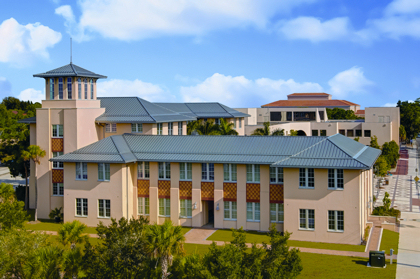
|
Above and below, more images of The New College of Florida in Sarasota, FL. Photos courtesy of Petersen. |
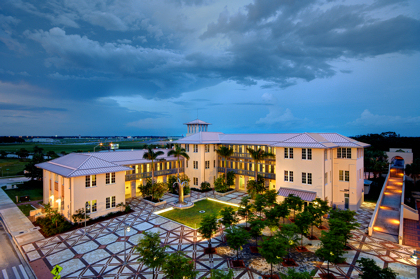
|
Protection From the Storm
The New College of Florida in Sarasota, FL was under pressure to meet the guidelines related to the Florida Department of Education’s Hurricane Shelter Approval, Miami-Dade’s NOA and Florida Building Approvals. In an effort to meet the strict guidelines and withstand harsh weather conditions, the team invested in an aluminum roof. The standing seam metal panels, coated with a durable architectural metal coating, were selected to equip the building with security as well as make an aesthetic statement.
Situated near the Gulf shoreline, it was necessary that NCF’s new academic center feature durable products. Working in tandem with masonry walls and hurricane shutters, the aluminum roof adds to the strength of the building and allowed architects to achieve their desired look of blending regional style and contemporary design. A strong architectural metal coating to finish the aluminum panels was a natural fit.
Weather-resistant architectural coatings are heralded for adhesion and color retention properties, which were sure to pay dividends under the Florida sun. Also formulated to stand up to harsh conditions, these coatings are the ideal product for the unpredictable coastal climate.
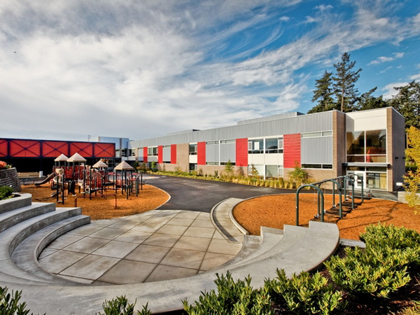
|
Designing a school to last 75 years led to the use of metal claddings for the exterior of the Bonny Slope Elementary School in Portland, OR. To protect the metal from the effects of salt air exposure, coatings from Valspar were specified. To see more on this project, click here. Photos courtesy of CENTRIA. |

|
Schooling Salt Deterioration
On the opposite side of the country, in Portland, OR, Bonny Slope Elementary school also faces salt deterioration and inclement weather. Longevity was king for the Bonny Slope project. With hopes for the building to last at least 75 years without major repair, the architects made sure to choose durable materials. As architectural metal coatings are also formulated to stand up to harsh weather conditions, they were the top choice for the coastal climate as well as a perfect match for Bonny Slope. Resistance to UV rays and acid rain paired beautifully with the high film integrity and excellent overall adhesion of the coatings. Three different coatings colors were used for this project’s pristine, long-lasting exterior metal panels. The pairing furthers the goal of a long life for Bonny Slope – even with the threats presented by a coastal climate.
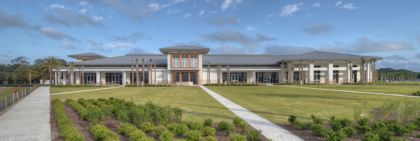
|
Subject to high winds and salt air exposure, the Jekyll Island Convention Center in Georgia was topped with a metal roof finished with architectural paint finishes from Valspar. To see more on this project, click here. Photos courtesy of Harlan Hambright. |
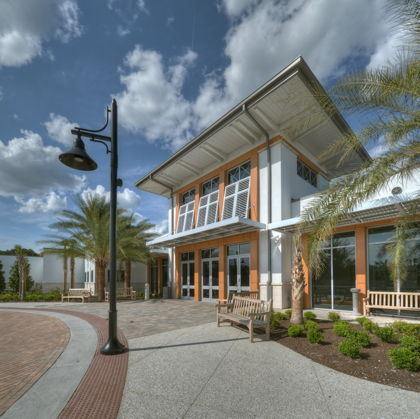
|
Unconventional Convention Center
With the strong winds of hurricanes and tornadoes in Southeast United States, attempting to counter the frequent weather risks of the warm Atlantic and Gulf climates can prove difficult. In the heart of this area, hugging the east coast of Georgia, is the historic and lavish Golden Isles, including Jekyll Island. With a desire to serve the vacationing population, and to bring in conferences of all sizes, a 128,000 square-foot convention center was constructed on the east side of the island.
The architects for this project wanted to ensure the new building matched the aesthetic of its surroundings while also bringing a modern and comfortable appeal to the island. When deciding on building materials, the architects were mindful of the coastal climate and chose to enlist a metal roof for its ability to stand up to the elements, especially when finished in a PVDF coating.
Along with providing a bold aesthetic, the architectural metal coatings and metal roof paneling protect the Jekyll Island Convention Center against the harsh and unpredictable weather conditions the area is known for. In addition to shielding the structure from inclement weather, the architectural metal coating and metal roof paneling safeguards the building from UV rays that beat down on Georgia, both on sunny and overcast days.
Structures near the coasts of the country endure different hardships from each unique climate. Coastal climates may be unpredictable, but equipping buildings with top-notch protection can improve overall longevity and help avoid the need to repair major damage. High-quality architectural coatings, be it classic or a thick film primer for those neighboring the ocean, and metal panels provide building owners with a comfortable starting point for achieving peace of mind when building near or on the coast.